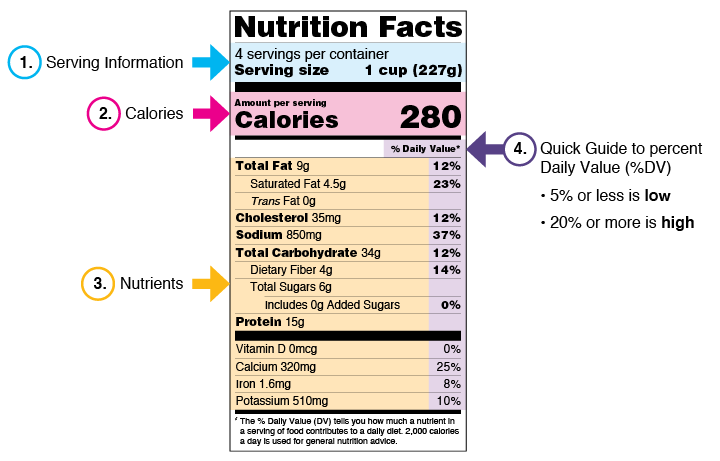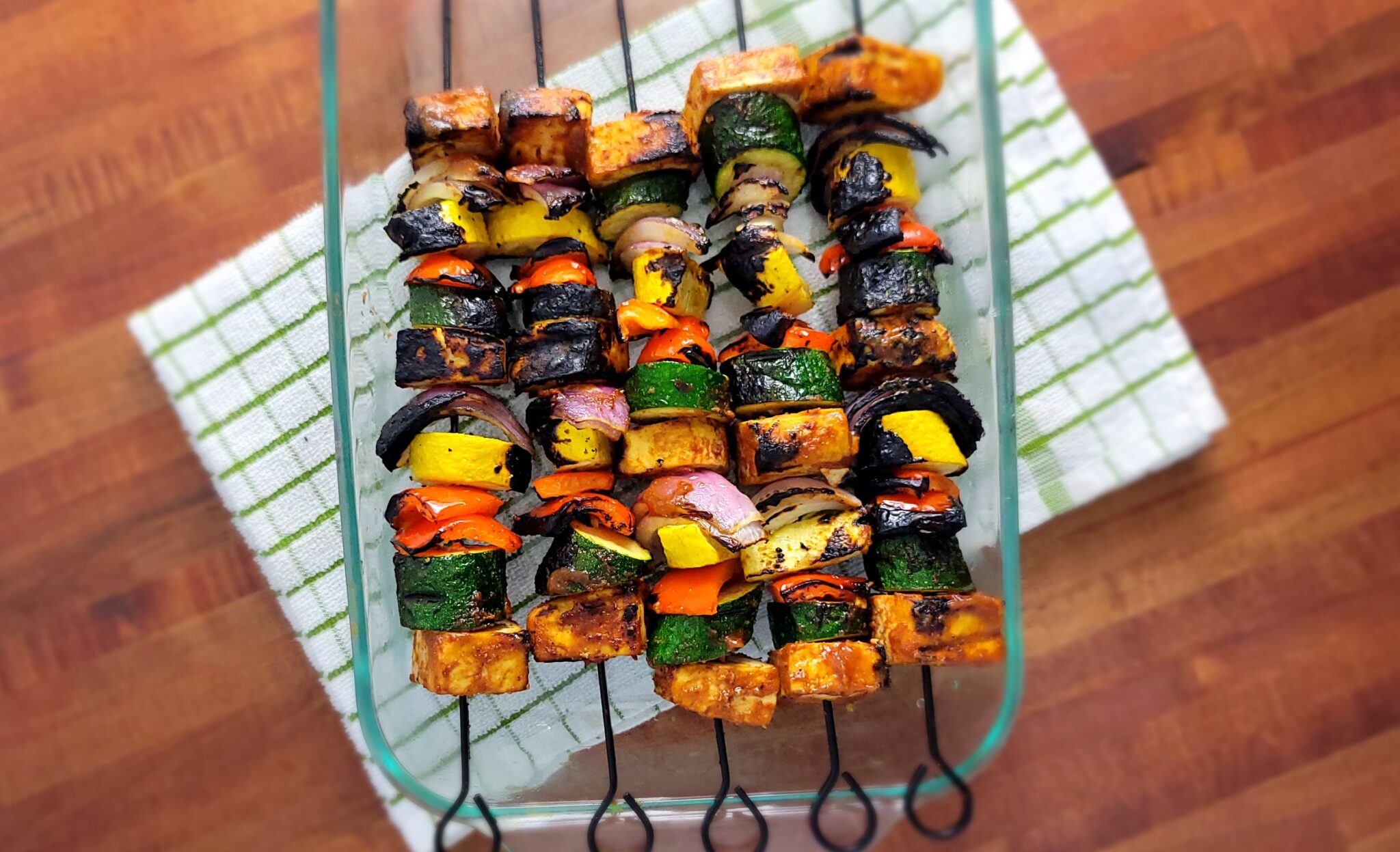Learn About Nutrition Labels & CKD
Understanding nutrition labels can seem challenging, but it becomes easier when you know how to read them. Many people with kidney disease are told to limit sodium, potassium, phosphorus, and protein. How do you put it together to choose healthy food? This guide breaks down the nutrition label for kidney health.
Introduction
Understanding how to read a nutrition label is essential for anyone living with chronic kidney disease. Each person’s diet needs are different depending on the stage of kidney disease, recent lab results, and doctor or dietitian recommendations. The food label is used to evaluate if a food is a healthy choice. The following guide will teach the basics of reading nutrition labels and help to make quick and easy kidney-friendly choices.
Below is a sample food label. The Food and Drug Administration’s (FDA) role is to regulate the labeling of packaged goods in the United States. The food label is broken down into four sections; 1) Serving Size, 2) Calories, 3) Nutrients, and 4) Daily Value. [1]

Serving Size
- Servings sizes are not health recommendations and are used to provide knowledge of the food content. This allows a side-by-side comparison of one product to another.
- Serving sizes are provided in basic units, such as cups or pieces, followed by a metric amount like the number of grams.
- It is crucial to know how many servings will be eaten in one sitting of any product.
Kidney Dietitian Tip
Serving sizes are critical to a kidney-friendly lifestyle. Be aware of how many servings you eat at one time. Make sure to consider the important nutrients like sodium, potassium, protein, fiber, added sugar, or any other nutrient your doctor or dietitian recommends.
Calories
- Calories measure how much energy you are getting from a specific food.
- The number of calories on the label is NOT the number of calories in the whole package! This is the number of calories per serving.
Kidney Dietitian Tip
One study showed that only 31.4% of young adults 25-36 years old read food labels. The study found that people who read food labels ate more fruits, vegetables, and whole grains and drank fewer sugar-sweetened beverages. (2) Reading food labels may be a valuable part of an overall healthy eating style.
Nutrients
The nutrient section of the food label includes fat, cholesterol, sodium, total carbohydrate, protein, vitamins, and minerals. These are mandatory nutrients required on the food label.
Total Fat Section
Total Fat
The total fat section is broken into total fat, saturated fat, and trans fat. All of these fats are written in grams (g). Fat has the most calories per gram (9 kcal/g) compared with carbohydrates (4 kcal/g) and protein (4 kcal/g). We receive more calories from fat per weight than carbohydrates and protein.
Saturated Fat
The Dietary Guidelines for Americans 2020-2025 recommend limiting saturated fats to 10% of total calories. [3] It should be noted that the American Heart Association recommends less than 6% of total calories come from saturated fat.[4] Following these guidelines is important because people with CKD tend to also be at risk for heart disease. [5]
For a 2000-calorie diet, this would mean no more than 20g of fat per day.
Trans Fat
Trans fat has been shown to increase LDL cholesterol (bad cholesterol) from both naturally occurring trans fat (milk, butter, cheese, meat products) and artificial trans fat (partially hydrogenated oils made from vegetable oil). In 2015, the FDA determined that artificial trans fats were no longer safe. [6] As a result, artificial trans fats are no longer allowed to be added to foods.
There will always be some trans fat in our food supply as it occurs naturally in animal products.
Cholesterol
Cholesterol is the waxy substance that makes up our cell membranes and hormones. Sources of cholesterol are animal products in the diet and the cholesterol that the body makes in the liver. Cholesterol travels in the bloodstream in many forms. The most notable are have LDL (bad) cholesterol and HDL (good) cholesterol. These cholesterol types are manufactured in the body and do not come from food.
It is recommended for all people consume no more than 300mg of cholesterol per day. (7)
Sodium
Sodium is a mineral and an essential electrolyte in the body. Sodium’s function in the body is muscle contraction and nerve function. Sodium also helps body fluids stay in balance. The kidneys work to regulate and maintain fluid balance. In kidney disease, the kidneys are not working well enough to keep the balance on their own. Often this can lead to high blood pressure and fluid build-up (swelling) with too much sodium in the diet. (8) The Daily Value for sodium intake is limited to 2300mg per day.[ ]
For more information on the recommendation for sodium per meal, check out the low sodium guide.
Total Carbohydrates Section
The total carbohydrates section of the food label is broken down into total carbohydrates, dietary fiber, total sugars, and added sugars. The measurement for total carbohydrates is in grams. The dietary fiber, total sugars, and added sugars are part of the total carbohydrate.
Dietary Fiber
Dietary Fiber is a type of carbohydrate that our body does not break down and use for energy. Instead, fiber absorbs water and nutrients in our gut and is passed into the stool. This important role helps maintain a healthy gut, prevent constipation, and reduce cholesterol and blood sugar spikes. The daily value for fiber is 28g per day. Examples of foods that contain fiber are; fruits, vegetables, beans, whole grains, and legumes.
Total Sugars
Total Sugars include both the naturally occurring sugar in a food product and the added sugar. This section can be helpful when trying to determine how much sugar the food naturally contains before any processing from the food manufacturer.
Added Sugar
Added sugar is the amount of sugar, in grams, added to a food product for flavor purposes. Overeating added sugar may increase your blood sugar, triglycerides, and body weight. If you are looking for more information on reducing added sugars check out this article from Harvard Health.
Protein
Protein is measured in grams, and our bodies take in 4 kcals per gram that we eat. There is no daily value (DV) for protein. Instead of looking for the DV, people with kidney disease should focus on how many grams of protein per serving. Protein recommendations for kidney disease vary based on stage. In general, protein intake should be limited during kidney disease stages 3-5, before the need for dialysis. If you are on dialysis, protein needs are higher than before. For more information on protein recommendations for kidney disease, check out our guide on Low Protein Diets.
Vitamin and Minerals
Vitamin D, calcium, iron, and potassium are all included on the food label. They are shown in both their units (mcg or mg) and the DV (%).
Vitamin D
Vitamin D has been shown to be a significant part of bone health. The kidneys play a role in bone health by activating vitamin D to its hormonal form. (9) The most significant source of vitamin D is from the sun. Typical food sources for vitamin D include fish and fortified food products such as orange juice and dairy products. For people with kidney disease, these foods are often recommended to be limited and therefore doctors often recommend taking a Vitamin D supplement.
Calcium
Calcium is the main component of our bones, and it is also used in muscle contraction and nerve function. Calcium is often found in dairy products, however, it is also in fruits and vegetables like kale, broccoli, oranges, and fortified foods. Calcium can be a tricky part of a kidney-friendly diet because often dairy products are recommended to be limited due to their high potassium and phosphorus content. Nondairy products may be a good option and they are often fortified with calcium. If following a vegan diet, be aware that a recent study showed a vegan diet is lower in calcium however, talk to your doctor before starting a calcium supplement. (10)
Iron
Iron is a mineral used to make red blood cells in our bodies. Red blood cells deliver oxygen throughout the body. The kidneys aid in red blood cell production. During the later stages of kidney disease, many people become feel weak and tired due to anemia (low iron) because the kidneys are not able to work as efficiently. It is important to eat enough iron (from food and/or supplements) to help maintain the proper amount of red blood cells. Foods that often include iron are beans, lentils, spinach, enriched bread, and meats such as chicken, fish, beef, and pork.
Potassium
Potassium was added to the food label in 2021. (11) Potassium is a mineral that is used to aid in muscle contraction in the body. Potassium is most often recognized for being in many fruits and vegetables (for example bananas) however, there is also potassium in meat like chicken, beef, and pork. Potassium can also be an additive to food products as well. Reading the food label is important for potassium. For Potassium the food label is marked in both grams and percentages. The Daily Value for potassium is 4700mg per day for generally healthy people. people with kidney disease may be told to limit potassium in their diet. It is important to follow your doctor or dietitian’s recommendation for potassium.
A typical, “low potassium” diet is 2000mg per day.
Looking at the mg of potassium in a serving may be more helpful than the percentage for potassium-restricted diets. For more information regarding potassium in your diet check out our potassium guide.
Daily Value (DV)
The % Daily Value (DV) tells you the percentage of each nutrient in a single serving in terms of the daily recommended amount. The DV is based on a healthy individual and does not take into account specific health conditions. People with kidney disease need to understand what their nutrient needs are when using the percent DV as a guide for food choice. Below is a list of the Daily Values for the nutrients above:
- Total Fat 78g
- Saturated Fat 20g
- Cholesterol 300mg
- Sodium 2300mg
- Total Carbohydrate 275g
- Fiber 28g
- Added Sugar 50g
- Protein 50g
- Vitamin D 20mcg
- Calcium 1300mg
- Iron 18mg
- Potassium 4700mg [7]
Ingredients
The ingredients are listed in weight order. The beginning of the list makes up most of the product and the ingredients at the end make up the least amount of the product. Reading the ingredient list is very important if you have kidney disease. Food additives are listed in the ingredients, and these additives are often adding phosphorus, potassium, or calcium to the product. Potassium and calcium are on the food label however, phosphorus is not. The ingredient section is the place to look for phosphorus additives. If you do not know where to start with phosphorus, check out our guide.
Kidney-Friendly Tips
There is a lot of information on the food label. Depending on the stage of kidney disease, individuals may be told to follow a low sodium, low or high protein, low or high potassium, and low phosphorus diet making food choices confusing.
Remember these simple steps when evaluating a food product:
Check out the specific nutrients you need to be aware of for your kidney health.
- Look at the sodium, potassium, and protein content of foods. Identify how they compare to your recommended diet.
Look at the serving size.
- Evaluate if the serving size is the same amount eaten at one time.
Check the ingredients for additives such as hidden phosphorus.
If this product doesn’t fit your health needs, make another choice that does.
- It does not mean that you can “never eat” that food, but you can look at another brand or version of the product (a great example is no added salt canned products).
Food labels are a tool intended to provide important information to make a healthy choice. Individual health needs are not the same for everyone. Using the food labels to determine which products are kidney-friendly is a doable task; it does take time. Making this a part of a grocery shopping habit will make food choices faster and easier in the long run. If you need more help, consider working with a renal dietitian.

